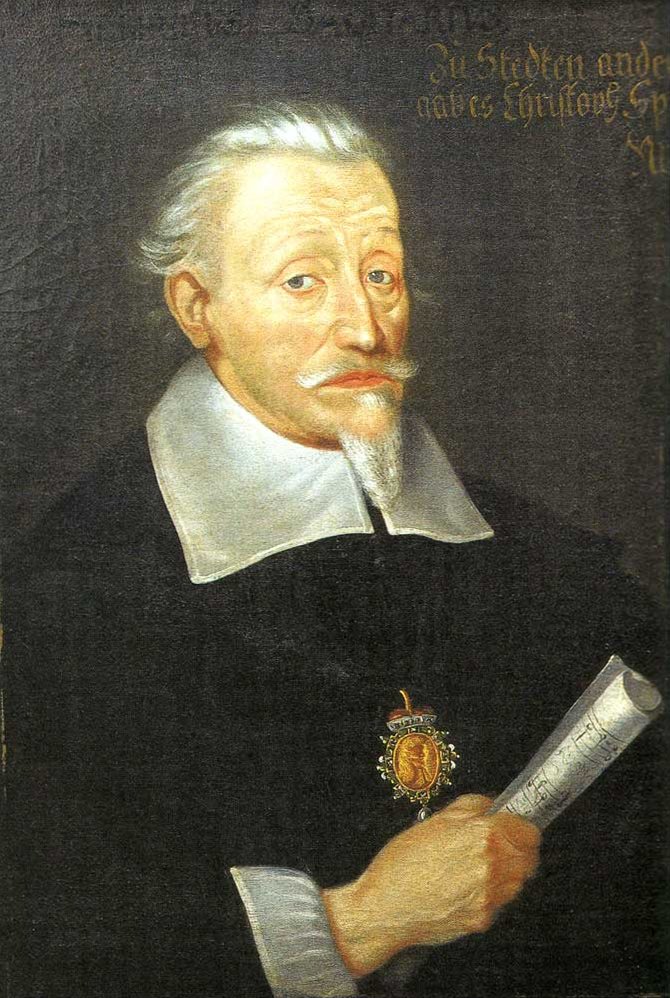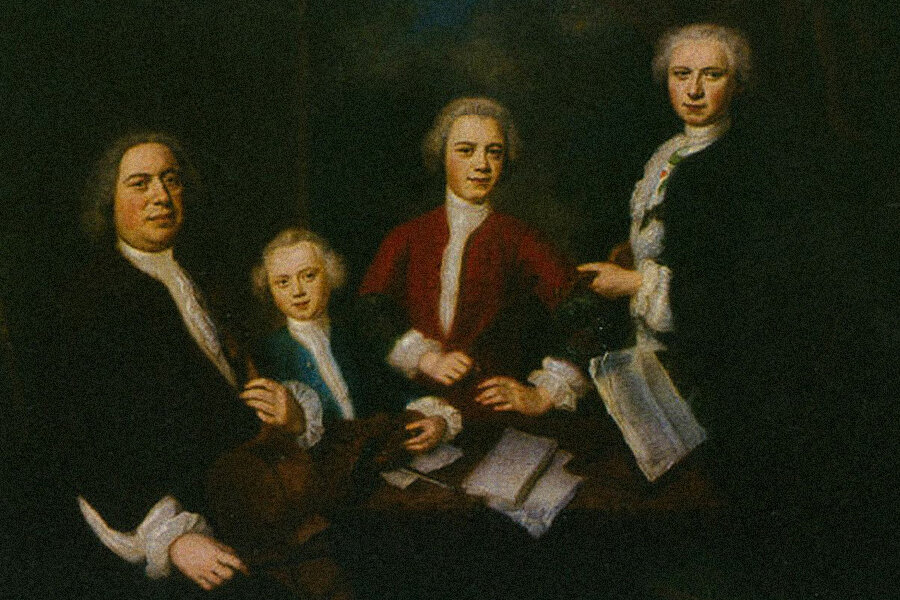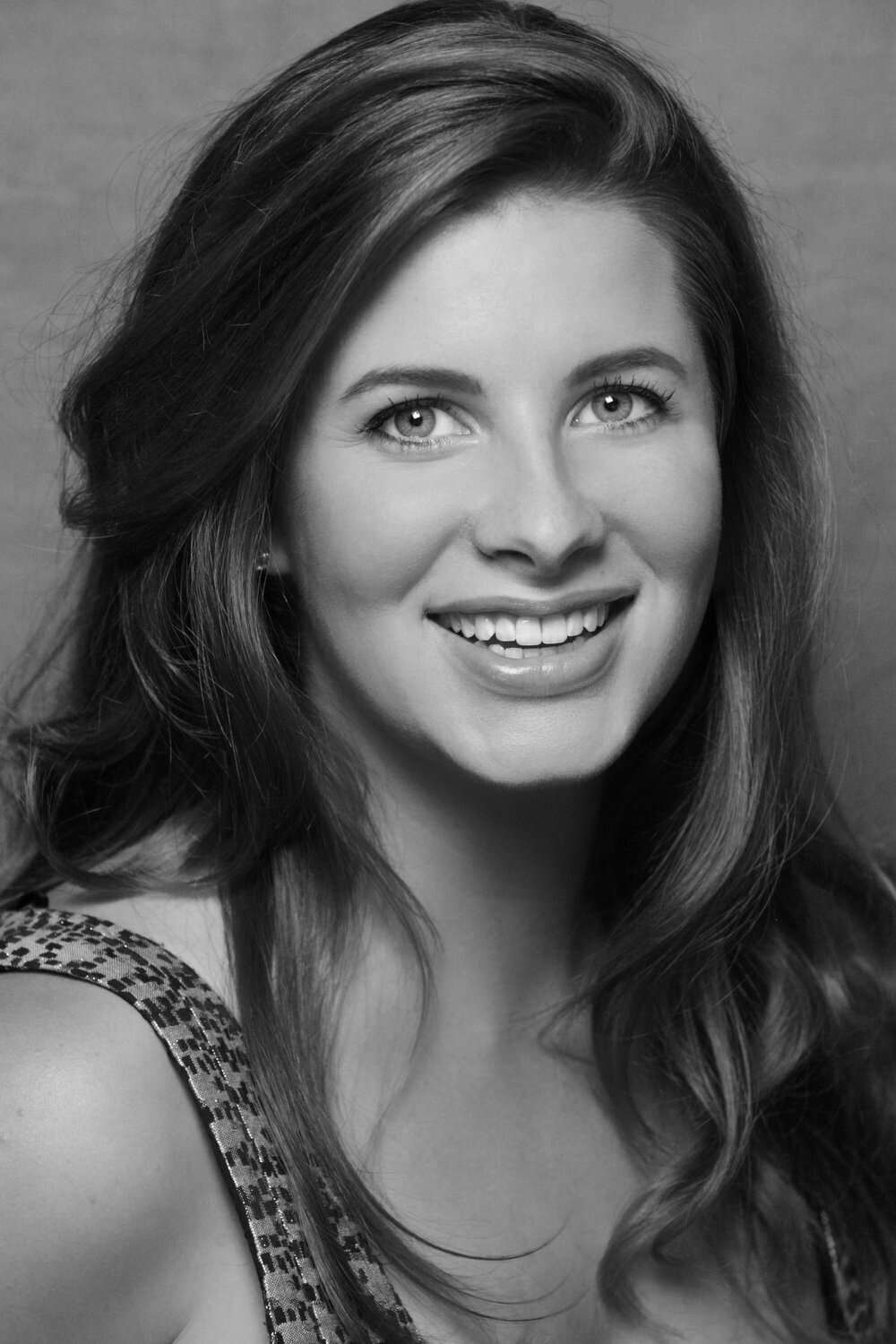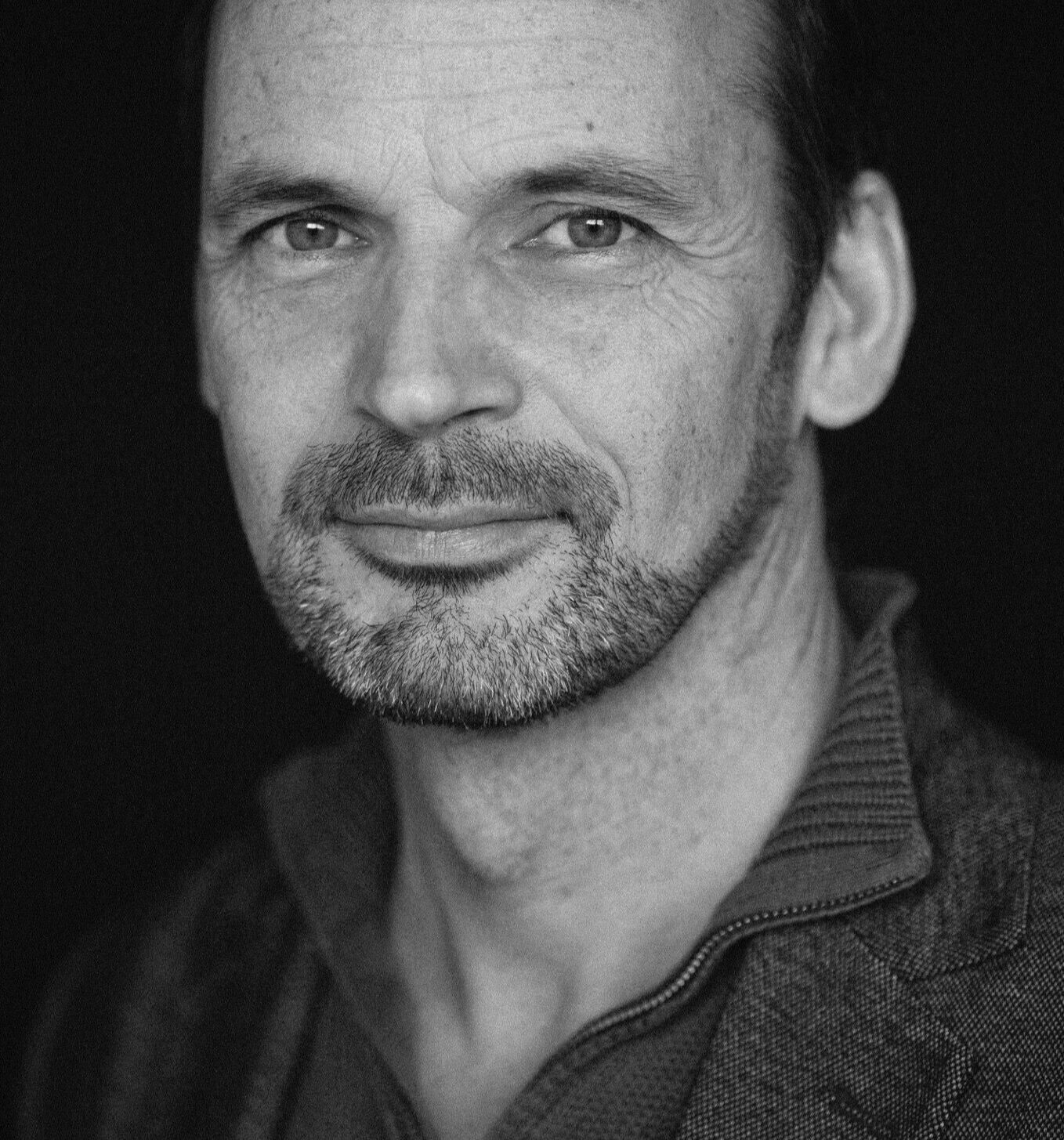Heinrich Schütz (1585–1772) is generally regarded as the most important German composer before Johann Sebastian Bach and one of the most important composers of the 17th century.
Heinrich Schütz
Historia der Geburt Jesu Christi is a setting of the Gospel that is intended to be performed during a service instead of the Gospel reading. It is a late work, composed when Schütz was 75 years old, and it features the more austere musical style that Schutz adopted late in life. Schütz had travelled a lot throughout his life and had lived through the Thirty Years' War; this contributed to the "serenity of the composer’s late works".
The music was probably first performed in a Christmas service at the court chapel of Johann Georg II, Elector of Saxony, in Dresden in 1660. The text is almost exclusively taken from the Bible in the translation by Martin Luther, quoting both Luke and Matthew. The work is framed by a choral Introduction and Beschluss (conclusion).
It is scored for soloists and choir in up to six parts (SSATTB) and orchestra. The Evangelist is a tenor singing secco recitative (following the patterns of speech rather than a strict rhythm), a tradition which Bach continued. Additionally, Schütz uses the “Italian dramatic recitative style” for these recitatives. Music historian Michael Zwiebach notes that this style “has unexpected twists that emphasize particular words, and it shifts tonal centers rapidly to reflect dramatic events." The angel is sung by a soprano with two violins (or treble viols), a trio of shepherds is accompanied by pastoral recorders, the words of the priests are set as a quartet. Herod is accompanied by trumpets (or sackbuts), setting his worldly power apart from the "more potent, less showy, heavenly host".
Samuel Scheidt (1587 –1654) was a German composer, organist, and teacher of the early Baroque era. Scheidt composed in two principal categories: instrumental music, including a large amount of keyboard music, mostly for organ; and sacred vocal music, some of which is a cappella and some of which uses a basso continuo or other instrumental accompaniment.
Nun komm der Heiden Heiland is a motet for double choir, which was written around 1635. The chorale tune is an Advent hymn, and it is handed off to different vocal parts as the music progresses.
Felix Mendelssohn (1809–1847) enjoyed early success in Germany; he revived interest in the music of Johann Sebastian Bach, notably with his performance of the St Matthew Passion in 1829. He was well received in his travels throughout Europe as a composer, conductor, and soloist; his ten visits to Britain—during which many of his major works were premiered—formed an important part of his adult career. After a long period of relative neglect due to changing musical tastes and antisemitism in the late 19th and early 20th centuries, his creative originality has been re-discovered. He is now among the most popular composers of the Romantic era.
Weihnachten is an eight-part motet from Mendelssohn’s series of motets (Sechs Spruche, Op. 79) for the Christian liturgical year. Mendelssohn composed these motets during the mid-1840s for the Cathedral Choir of Berlin. This motet’s relative brevity, exuberance, lyricism, and rich uncomplicated harmonic style are typical of many of his sacred choral compositions.
Mikołaj Zieleński (1560–1620) was a Polish composer, organist, and Kapellmeister to the primate Baranowski, Archbishop of Gniezno. This motet is from the Offertoria/Communes totius anni, which contains his only surviving compositions. Lætentur cæli (The Heavens Rejoice) is written for two equal choirs in the Venetian Baroque style. The text (from Psalm 95) is used for the offertory for Christmas Eve Midnight Mass.
Maciej Małecki (b. 1940) is a Polish composer and pianist. He studied at the Frederic Chopin Academy of Music (graduating 1965) and the Eastman School of Music, in Rochester, New York
Lulajże, Jezuniu (Lullaby Little Jesus) This is the best-known Polish Christmas carol. A young and homesick Frederic Chopin incorporated this melody into the middle section of his B minor Scherzo. Małecki’s arrangement was originally for voices, soprano soloist, and orchestra. We thank him for this special arrangement with piano accompaniment, which he graciously made for the California Bach Society.
Giovanni Croce (1557–1609) was an Italian composer of the Venetian School in the late Renaissance. He was particularly prominent as a madrigalist. Stylistically, Croce was more influenced by Andrea Gabrieli than his nephew Giovanni; Croce preferred the emotional coolness, the Palestrina clarity, and the generally lighter character of Andrea's music. Croce’s sacred music shows a development from the even-textured style of Palestrina to the more modern Venetian style of his day.
Quaeramus cum pastoribus, a double choir motet for Christmastide, features the typical “call and response” writing, but it does not adhere fully to that Venetian style, as sometimes a question-and-answer alternates between the two choirs (the typical Venetian treatment), and at other times each choir asks and answers the questions by itself. The two choirs separate and join, creating varied textures and sonorities. Sections of the motet are separated by the traditional “noe, noe” Christmas response.
Verbum caro factum est (The Word was Made Flesh) was arranged by the noted Waverly Consort founders and leaders, Mike and Kay Jaffee, and featured on their 1999 CD The Christmas Story. The Consort was founded in 1964 to explore the sounds and styles of early musical repertoire. A review of this CD states: “One of the more interesting selections is the 14th century Italian lauda ‘Verbum caro factum est’. . .that shows just how able and artful this group is in preserving the music’s ancient-ness while making it alive and immediately appealing to modern listeners.” —David Vernier, ClassicsToday.com
The lauda was the most important form of vernacular sacred song in Italy in the late medieval era and Renaissance. It was often associated with Christmas, and so is in part equivalent to the English carol, French noël, Spanish villancico, and like these genres occupies a middle ground between folk and learned lyrics. After 1480 the singing of laude was extremely popular in Florence since the monk Savonarola (and others) had prohibited the dissemination of any other style of sacred vernacular music.
Ivar Widéen (1871–1951) was a Swedish organist and composer. Widéen was greatly inspired by the music of Richard Wagner, Edvard Grieg, and August Söderman. He had a prominent role in Swedish choral music. He was principal conductor of the Småland Sångarförbund and led that choir at annual national choir festivals.
På krubbans strå (In the Manger Straw) is a sweet and understated setting of a hymn from the Swedish Psalm Book, addressing Jesus in the manger.
Johannes Berckelaers (15?–16?) was a Flemish composer working in Antwerp. The Cantiones natalitiae (Birth Songs) is a collection of settings of traditional Christmas carols by lesser-known church composers from Ghent, Antwerp, and Brussels. They are Flemish (and occasionally Latin) Christmas texts and tunes, most of which had existed since the Middle Ages and were widely popular in the sixteenth and seventeenth centuries throughout the Low Countries.
Hoe leyt dit kindeken is a four-part song from this collection, arranged in a simple verse form with the tune set in the top voice. It is believed that these songs were sung during the placing of the Christ Child figure in the manger during the Christmas service. Parents took their children into the church, with each child having a crib with a bell attached to it. When during the mass the priest began to rock the baby on the altar and sang Eia, eia, eia, all the children also rocked their cribs and sang Eia. This was accompanied by a lot of noise and bells ringing. The words Sus sus, na na na kindeken probably refers to this practice.
John Paynter (1931–2010). Raised in a working-class family in South London, Paynter was a passionate advocate for choral music and music education.
The Rose (1969), a setting of an anonymous text from the 15th century, was composed for a choir divided into two parts, with alto and baritone solos. “The gradual ‘unfolding’ of the music symbolizes the opening of the rose (and its closing during the final stanza)," writes Paynter. “The music does try to suggest the suspension of time, such as one has with the opening of a flower: it grows yet it does not appear to move (hence the lack of harmonic movement). Such movement as there is emphasizes the change in vocal colors rather than changes of harmony.” Near the middle, Paynter has the main choir (Choir I) ad-lib the durations of the words they sing to a G major chord while Choir II adds on “fragmentary statements at the indication of the conductor” so as to create an effect of “bell-harmonics or the sympathetic reverberation of harmonics on strings.” —Los Angeles Master Choir program notes, December 2016.
Peter Warlock (pseudonym of Philip Arnold Heseltine, 1894–1930) was a talented, troubled, and eccentric British composer and author. Early on, he was strongly influenced by Frederick Delius. He was almost entirely self-taught, and admired the music of Debussy, Liszt, and Bartok. His songs alternate between the lyricism of Delius and a roistering spirit reminiscent of the first Elizabethan age. His personality veered between extroverted, heavy-drinking joviality, and neurotic introspection. And he has also been described as a supreme “carrolist” of the century, perhaps of all time.
The First Mercy (1926) was originally a solo song and an early collaboration between the composer and Bruce Blunt, with whom he would soon after write perhaps his best-known choral work, Bethlehem Down. Warlock arranged the carol for upper voices (SSA) and piano in 1927. It is a simple carol with mostly homophonic textures and some of Warlock’s characteristic harmonic twists,
Where Riches is Everlastingly is set for four-part chorus and organ. The text is from the early 16th century. Rhythmic and graceful, it alternates between unison and part writing.
Marc-Antoine Charpentier (1643–1704) was a French composer of the Baroque era. Exceptionally prolific and versatile, Charpentier produced compositions of the highest quality in several genres. His mastery in writing sacred vocal music, above all, was recognized and hailed by his contemporaries.
Salve puerule (Hail, little boy) is the last movement of Charpentier’s Christmas cantata In Nativitem Domini nostril Jesu Christi. Each verse of this five-part setting is set apart by a charming instrumental ritornello.
Sources
Wikipedia
Los Angeles Master Choir
ClassicsToday.com
The Peter Warlock Society
Patricia Jennerjohn


















